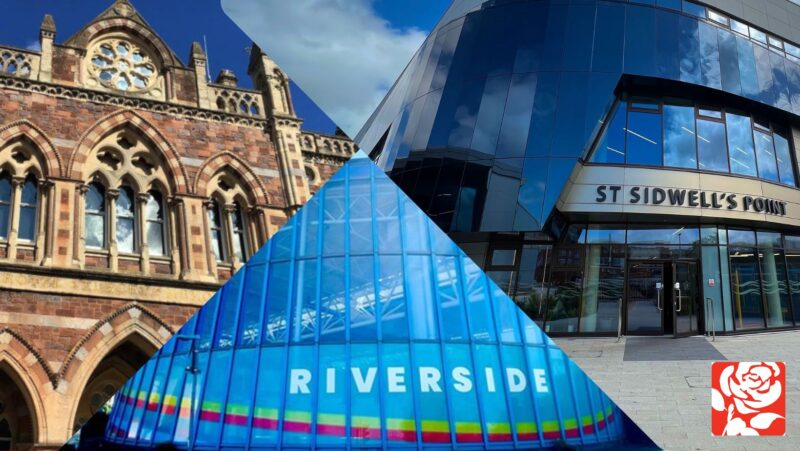
Three buildings from three different ages, the Royal Albert Memorial Museum (RAMM) built in 1868, the Riverside Leisure Centre built in 1986 and St Sidwell’s Point built in 2022. All with the same challenge to minimise emissions whilst providing quality facilities for the public to enjoy into the 21st century.
Labour led Exeter City Council has been working for almost a decade on reducing energy use and carbon emissions by implementing energy-efficient measures across all its buildings. The Royal Albert Memorial Museum and Riverside Leisure Centre have both undergone renovations to reduce their carbon footprint and improve energy efficiency. The work began many years ago with some of the major works being carried out in collaboration with local energy efficiency experts. These aimed to reduce energy consumption and carbon emissions by installing new technologies and improving insulation in the buildings. The project is part of the Council’s wider efforts to reduce carbon emissions and tackle climate change.
The Royal Albert Memorial Museum, is one of the Council’s oldest buildings and creates the largest carbon footprint of any of its buildings. Among other measures an energy-efficient lighting system has been installed, reducing energy for lighting consumption by up to 80%. The lighting system is equipped with motion sensors, which means that the lights only come on when people are present, reducing energy waste and in 2015 a 26kw Solar PV array was fitted to the roof of the grade II listed building. There is the potential that further funding will enable a new environmental management system and more significant works to be carried out 2023 / 24. So great progress is being made with a challenging building which is definitely not designed to be low carbon.
At the Riverside Leisure Centre, the Council has installed a new combined heat and power (CHP) system. The CHP system generates electricity on-site, which is then used to power the building. The system also captures waste heat generated during the electricity generation process and uses it to heat the building’s water supply, reducing the need for additional heating. As part of the European ESF funded project, that built the solar farm to power the waste collection fleet the Riverside Leisure Centre, the council has also installed solar panels on the roof of the Riverside Leisure Centre. The panels are expected to generate around 75,000 kWh of electricity per year. To give us an idea of scale just this element of this one building would save around 25 tonnes of carbon per year.
Once more there is the potential for significant works planned for the Riverside Leisure Centre to reduce emissions even more in 2023 / 24.
Finally, St Sidwells Point Leisure Centre, the UK’s first passivhaus leisure centre sets a bench mark in energy efficiency and healthy building standards for other Cities across the country to aspire to. A building built in the 21st century designed to meet the challenges of predicted climate changes, it delivers a facility able to cope with the spiralling energy costs at a time when other council run pools are being forced to close.
It’s been interesting to see that the Green Party are the latest party to work in opposition, as Labour seeks to lower emissions. They took up the role just a year ago, but Labour will continue to drive down emissions where ever it can. These works are just part of the Council’s wider commitment to reducing carbon emissions and tackling climate change. Exeter City Council has set a target of becoming net zero carbon by 2030, and this project is just one of the many initiatives they are implementing to achieve this extremely challenging goal.

